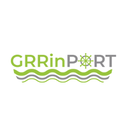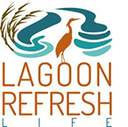Projects concluded
 |
The Banquette di Posidonia: integrating knowledge and promoting a model of ecological beach with responsible management Project financed under the Call of the Lazio Region "Research Group Projects", has the objective of identifying and promoting eco-sustainable and innovative management strategies of Posidonia accumulations on sandy shores at a regional level. |
 |
The GEREMIA project, funded under the 2nd Notice of the Italian-France Maritime Cross-Border Cooperation Program 2014-2020, aims to define tools of "governance" for the prevention and containment for pollution control and the improvement of water quality in ports, as well as the development of innovative systems to assess the waters quality in the Italy-France cross-border area |
 |
GRRinPORT (Sustainable management of waste and wastewater in ports) is a project launched in April 2018 and will last 36 months, until 2021. GRRinPORT aims to improve the quality of marine waters in ports by limiting the impact on the environment of the activity port and maritime traffic. |
 |
Harmonization and Networking for contaminant assessment in the Ionian and Adriatic Seas HarmoNIA (Harmonization and Networking for contaminant assessment in the Ionian and Adriatic Seas ) project is financed by Interreg ADRION Programme - objective 2.2. HarmoNIA intends to address the heterogeneity in methodological approaches and in the information used for Good Environmental Status assessment (GES, sensu MSFD) and to overcome the fragmentation in geographical coverage of data availability on contaminants. |
 |
Italian-Maltese harmonization for a good state of the environment: sea floor integrity and interaction with invasive species to preserve marine ecosystems functioning |
 |
IMPACT tackles the challenge of managing protected marine areas (PMA) near port zones. The objective is to define cross-border sustainable management plans for the effective protection of PMAs in harmony with the development requirements of ports, fundamental elements of Blue Growth. Furthermore, the project will provide indispensable support to the governing bodies responsible for implementing the Marine Strategy Framework Directory: the partners Regione Toscana, ISPRA (Italy) and Ifremer (France) have long been directly involved in this process. |
 |
INDICIT II |
 |
The LIFE LAGOON REFRESH project provides for the restoration in the "Laguna Superiore di Venezia" SCI (IT3250031) of the ecotonal environment typical of microtidal lagoons, characterized by a marked saline gradient and large intertidal surfaces vegetated by reeds (mainly Phragmites australis). |
 |
The activities of the project "Marine knowledge sharing platform" funded by the program "Science with and for Society" of the Community Programme for Research and Innovation Horizon 2020 began on May 1, 2016 and have a duration of 36 months. The project, of which ISPRA is a partner, is coordinated by the Institute for Research on Population and Social Policies (IRPPS) of the National Research Council. The consortium of project involves 14 partners from 12 different Member States and countries associated with the H2020 program, who are committed to the goal of implementing the principles of responsible research and innovation (RRI) to improve citizen involvement in initiatives adopted by the European Commission to tackle the main and most current social challenges. |
 |
The MYOCEAN project aims to provide products and services for all marine applications: Safety, Resources, Environment and Climate, through a validated and user-commissioned sustainable ocean monitoring service. The follow up of the MyOcean2 project continues from April 2012 to September 2014 to ensure a continuation and extension of the services and control systems already implemented. |
 |
The ML-REPAIR project, capitalizing the results of the Adriatic IPA CBC DeFishGear project, is aimed at strengthening joint governance on marine litter management and developing solutions among different entities for reducing and preventing marine pollution. The main project activities are focused on testing new educational tools for raising awareness of tourists in the coastal areas and supporting the strategies for removing marine litter through the active engagement of the fishermen community. |
 |
The main objective of the MyOcean Follow On project will be to operate a rigorous, robust and sustainable Ocean Monitoring and Forecasting component of the pre-operational Copernicus Marine Service delivering ocean physical state and ecosystem information to intermediate and downstream users in the areas of marine safety, marine resources, marine and coastal environment and weather, climate and seasonal forecasting. |
 |
Monitoring, census, collection and start of recycling of ghost nets: fishermen protagonists of safeguarding the sea The project aims to make a tangible contribution to resolving the problem of floating waste deposited on the seabed, responsible for a direct and very serious environmental impact on the ecosystem and protected habitats and species. |
|
|
The main purpose of MyWave is to establish the basis for a future Marine Core Service that includes sea waves. The proposal identified four areas where coordinated research is needed to establish a high-level GMES Marine Core Service for sea waves: increase the use of ground-based observations by improving related algorithms and data assimilation systems, improve physics in current wave models and provide a basic framework for coupled model systems (atmosphere/wave/ocean), set a new standard for probabilistic wave predictions based on ensemble methods, derive standard protocols for validation of results. |
|
|
The Plastic Busters project, to free the Mediterranean from plastic, supported by numerous partners including ISPRA, is a project that aims to define the macro and microplastics that pollute the Mediterranean, illustrate the consequences they generate on the marine environment and on the health of its fauna and implement the necessary actions to plan, at an international level, interventions to mitigate and reduce the phenomenon. |
|
|
The Project started the first February 2018, has a duration of 48 months and is coordinated by ISPRA. The Plastic Busters MPAs is an Interreg Med funded project with the aim to contribute to maintaining biodiversity and preserving natural ecosystems in pelagic and coastal protected areas by consolidating Mediterranean efforts against marine litter. |
 |
The SEDRIPORT project (SEdiment, Dredging and PORT RIsk assessment) aims to develop, in the cross-border area, a shared system for the constant monitoring of silting, weather conditions, physical parameters of waters and sediments in ports and adjacent coastal areas and to define common strategies for seabed restoration. |
 |
The project aims to increase the efficiency of planning and control of the replanting of Posidonia oceanica (priority habitat sensu HD - 1992/43/EEC), carried out as a work to compensate for the damage caused by coastal works and infrastructures subject to of Environmental Impact (VIA), through electronic information systems, guidelines, technical-scientific manuals and training courses.
|
 |
The project searches for new ingredients and underused raw materials to be used in feed for the main fish species reared in Italy (sea bass, sea bream and trout), with the aim of improving the biological performance of the species fed with innovative diets and the environmental footprint. The species are fed with flours obtained from insects, crustaceans, micro-algae and by-products of poultry slaughter. |



